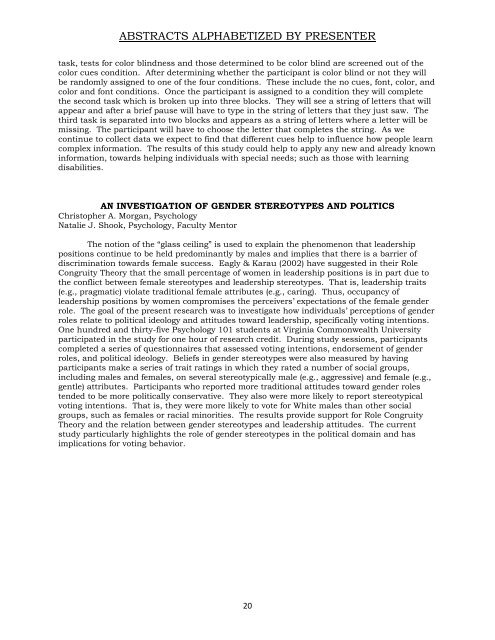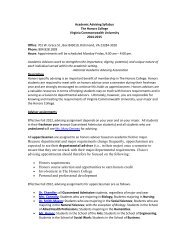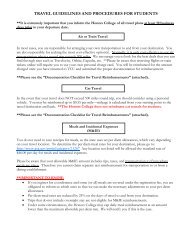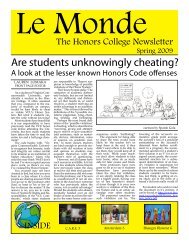here - VCU Honors College - Virginia Commonwealth University
here - VCU Honors College - Virginia Commonwealth University
here - VCU Honors College - Virginia Commonwealth University
Create successful ePaper yourself
Turn your PDF publications into a flip-book with our unique Google optimized e-Paper software.
ABSTRACTS ALPHABETIZED BY PRESENTER<br />
task, tests for color blindness and those determined to be color blind are screened out of the<br />
color cues condition. After determining whether the participant is color blind or not they will<br />
be randomly assigned to one of the four conditions. These include the no cues, font, color, and<br />
color and font conditions. Once the participant is assigned to a condition they will complete<br />
the second task which is broken up into three blocks. They will see a string of letters that will<br />
appear and after a brief pause will have to type in the string of letters that they just saw. The<br />
third task is separated into two blocks and appears as a string of letters w<strong>here</strong> a letter will be<br />
missing. The participant will have to choose the letter that completes the string. As we<br />
continue to collect data we expect to find that different cues help to influence how people learn<br />
complex information. The results of this study could help to apply any new and already known<br />
information, towards helping individuals with special needs; such as those with learning<br />
disabilities.<br />
AN INVESTIGATION OF GENDER STEREOTYPES AND POLITICS<br />
Christopher A. Morgan, Psychology<br />
Natalie J. Shook, Psychology, Faculty Mentor<br />
The notion of the “glass ceiling” is used to explain the phenomenon that leadership<br />
positions continue to be held predominantly by males and implies that t<strong>here</strong> is a barrier of<br />
discrimination towards female success. Eagly & Karau (2002) have suggested in their Role<br />
Congruity Theory that the small percentage of women in leadership positions is in part due to<br />
the conflict between female stereotypes and leadership stereotypes. That is, leadership traits<br />
(e.g., pragmatic) violate traditional female attributes (e.g., caring). Thus, occupancy of<br />
leadership positions by women compromises the perceivers’ expectations of the female gender<br />
role. The goal of the present research was to investigate how individuals’ perceptions of gender<br />
roles relate to political ideology and attitudes toward leadership, specifically voting intentions.<br />
One hundred and thirty-five Psychology 101 students at <strong>Virginia</strong> <strong>Commonwealth</strong> <strong>University</strong><br />
participated in the study for one hour of research credit. During study sessions, participants<br />
completed a series of questionnaires that assessed voting intentions, endorsement of gender<br />
roles, and political ideology. Beliefs in gender stereotypes were also measured by having<br />
participants make a series of trait ratings in which they rated a number of social groups,<br />
including males and females, on several stereotypically male (e.g., aggressive) and female (e.g.,<br />
gentle) attributes. Participants who reported more traditional attitudes toward gender roles<br />
tended to be more politically conservative. They also were more likely to report stereotypical<br />
voting intentions. That is, they were more likely to vote for White males than other social<br />
groups, such as females or racial minorities. The results provide support for Role Congruity<br />
Theory and the relation between gender stereotypes and leadership attitudes. The current<br />
study particularly highlights the role of gender stereotypes in the political domain and has<br />
implications for voting behavior.<br />
20








